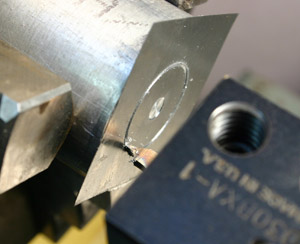by Steve Acker
One of my customers brought in an old lever-action rifle with a centrally mounted hammer. While in pretty good shape overall, the hammer was very loose in the frame side-to-side. The hammer pivot pin and the pivot hole in the hammer were badly worn. He wanted to reduce the side-to-side play of the hammer in the frame but not alter the parts in any way.

I suggested that we make two washers, one for each side of the hammer, to take up the side-to-side play. This would not fix the worn pivot hole in the hammer or the wear on the hammer pin, but would reduce their impact on the side-to-side play. Feeler gages were used to get a rough idea of how much washer thickness would be needed to correct the problem. Since these washers would not be visible after installation, the surface finish did not have to be perfect. The washers could be blued to further reduce their visibility in the rifle if needed.
Machining thin washers for gun parts is not uncommon. Over the years, I’ve had to make shim washers for triggers and other parts in sizes or thicknesses that were not available commercially. Many of the applications for this work come from repairing revolvers, such as adjusting Smith and Wesson revolver cylinder endplay. Often this technique is used to make a spacer that will allow repaired assemblies to index together properly. Many times when two washers are required, one on either side of a part, only one has to be machined to a specific thickness to get the required fit.
This work is entirely custom one-off lathe work. The washer material, hardness, thickness, outside diameter, and inside diameter have to be determined and the washer machined to those dimensions. Making a precision washer in this manner is a two-step process. The first step involves cutting the inside and outside diameters of the washer. The second step is machining the washer to the correct thickness.
“Machining Thin Washers for Firearms” appeared in the August/September 2009 issue of Machinist’s Workshop.
